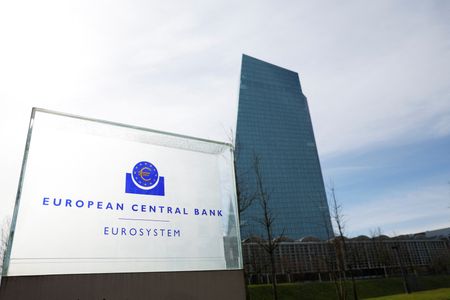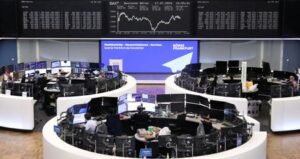By Marc Jones
LONDON (Reuters) – Europe’s traders were trying to pull stock markets out of tech-led tumble on Thursday, as attention turned to whether the European Central Bank would signal September is its next likely point to cut interest rates.
It was already a busy day.
Japan’s yen had scaled a six-week high amid speculation of an sustained intervention, while the equity markets were still shaky after chipmaker tariff worries gave the Nasdaq its worst day since December 2022 on Wednesday. [.N]
Bond markets were broadly steady and at $1.0930 the euro was holding near a four-month peak against an unusually subdued dollar ahead of the ECB meeting where the questions were all on when it cuts next.
Given that the bank’s policymakers have not been pushing back against current market expectations, BNP Paribas economist Luca Pennarola said “barring any shocks” September was their preferred date for the next rate cut.
His colleague Mariana Monteiro said it would be important to hear whether Thursday’s decision – in which rates are expected to be kept unchanged – will be unanimous given an emerging divergence over a potentially spluttering economic recovery but also stubborn pockets of inflation.
Back in the FX market, the U.S. dollar was loitering close to its weakest level in four months against a basket of currencies.
Comments from Federal Reserve officials have bolstered the case for September cut in the U.S. That in turn meant gold was perched near its recent record highs.
European stocks were battling to stay positive with the STOXX 600 on track to snap a three-session losing streak. Oil and gas boosted the benchmark index with a 1% rise, as the sector tracked higher crude prices.
Tech was 0.75% lower again after a 4.4% slump on Wednesday – also its worst day since December 2022 – following a report that the United States was considering tighter curbs on exports of advanced semiconductor technology to China. [.EU]
MSCI’s broadest index of Asia-Pacific shares outside Japan has seen a sub-index of IT stocks drop 2.5% overnight. Tech-heavy South Korean shares slipped 1.5%, while Taiwan stocks fell 2%.
The yen’s strength and the sharp drop in chip stocks took Japan’s Nikkei down more than 2%.
“This volatility spike is now leading to some broader risk reduction as investors worry about stretched positioning,” said Ben Bennett, Asia-Pacific investment strategist at Legal and General Investment Management.
TAKE, TAKE, TAKE
Broader risk sentiment also took a hit after Republican presidential candidate Donald Trump said on Wednesday Taiwan “did take about 100% of our chip business” and should pay the U.S. for its defence as it does not give the country anything.
China stocks had wavered as investors awaited policy news from a key leadership gathering in Beijing. The Shanghai Composite index made a late push to end up 0.55% although the tech sector still finished down.
The dollar index, which measures the U.S. currency versus six peers, was 0.1% higher at 103.78, not far from the four-month low of 103.64 it touched on Wednesday.
The yen hit a six-week high against the dollar at 155.375 in early trading after a sharp rise on Wednesday that had traders suspecting Japanese authorities were once again in the market supporting the currency. It was last at 156.
Bank of Japan data suggested Tokyo may have bought nearly 6 trillion yen last week to lift the frail yen away from the 38-year lows it has been rooted to since the start of the month.
The yen has dropped 9.5% against the dollar this year as the wide interest rate difference between the U.S. and Japan weigh, creating a lucrative trading opportunity, in which traders borrow the yen at low rates to invest in dollar-priced assets for a higher return, known as carry trade.
Analysts, however, said last week’s suspected moves by Tokyo might lead to traders unwinding some of their positions.
“It feels like the tide is shifting a little here and it’s generating some discomfort for yen funded carry traders,” said James Athey fixed income portfolio manager at Marlborough Investment Management.
In commodities, gold was 0.5% higher at $2,469 per ounce just below the record high of $2,483.60 it touched on Wednesday. [GOL/]
Oil prices were on the rise again, with Brent futures 0.4% higher at $85.45 a barrel, while U.S. West Texas Intermediate (WTI) crude gained 0.7% to $83.43. [O/R]
(Additional reporting by Ankur Banerjee in Singapore; Editing by Arun Koyyur)





